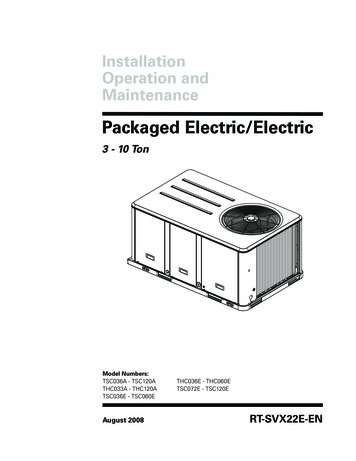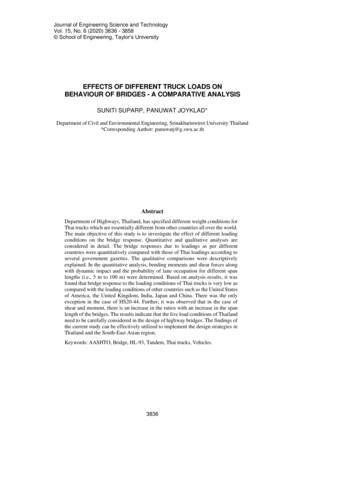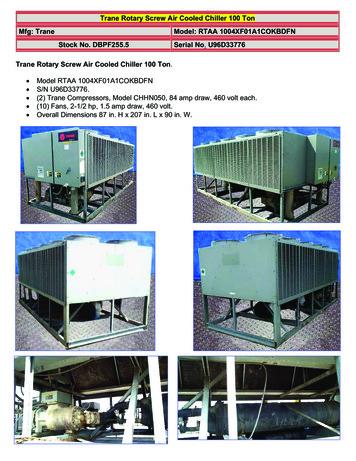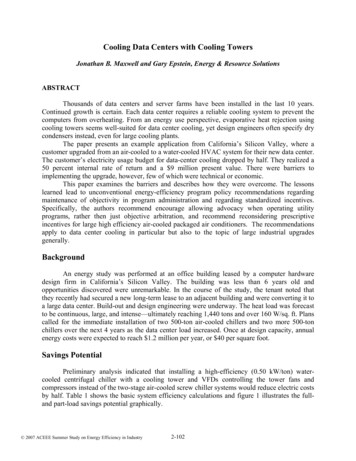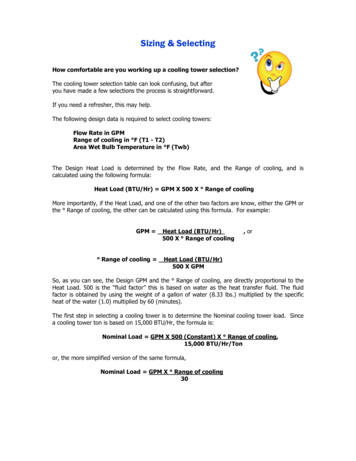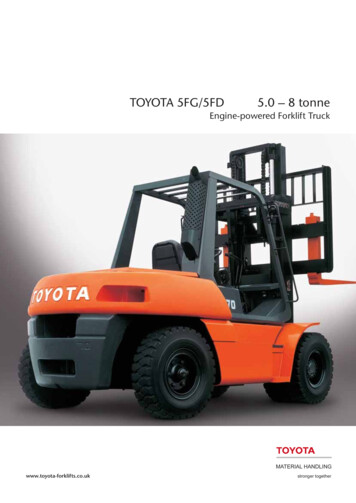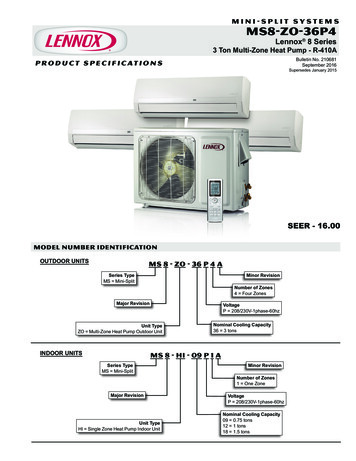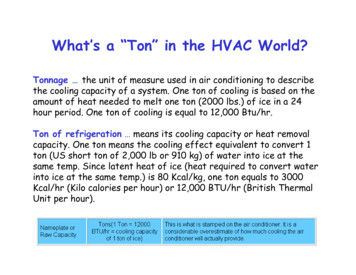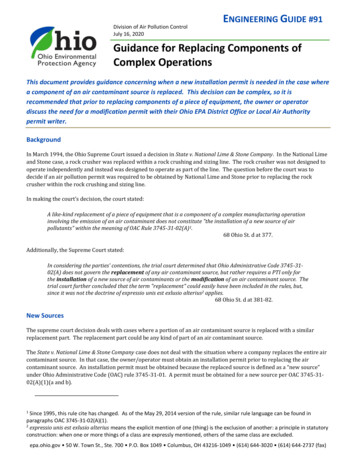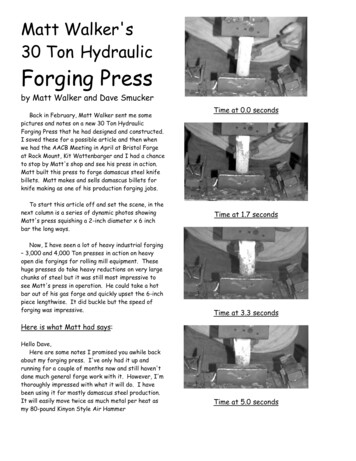
Transcription
Matt Walker's30 Ton HydraulicForging Pressby Matt Walker and Dave SmuckerBack in February, Matt Walker sent me somepictures and notes on a new 30 Ton HydraulicForging Press that he had designed and constructed.I saved these for a possible article and then whenwe had the AACB Meeting in April at Bristol Forgeat Rock Mount, Kit Wattenbarger and I had a chanceto stop by Matt's shop and see his press in action.Matt built this press to forge damascus steel knifebillets. Matt makes and sells damascus billets forknife making as one of his production forging jobs.To start this article off and set the scene, in thenext column is a series of dynamic photos showingMatt's press squishing a 2-inch diameter x 6 inchbar the long ways.Now, I have seen a lot of heavy industrial forging– 3,000 and 4,000 Ton presses in action on heavyopen die forgings for rolling mill equipment. Thesehuge presses do take heavy reductions on very largechunks of steel but it was still most impressive tosee Matt's press in operation. He could take a hotbar out of his gas forge and quickly upset the 6-inchpiece lengthwise. It did buckle but the speed offorging was impressive.Time at 0.0 secondsTime at 1.7 secondsTime at 3.3 secondsHere is what Matt had says:Hello Dave,Here are some notes I promised you awhile backabout my forging press. I've only had it up andrunning for a couple of months now and still haven'tdone much general forge work with it. However, I'mthoroughly impressed with what it will do. I havebeen using it for mostly damascus steel production.It will easily move twice as much metal per heat asmy 80-pound Kinyon Style Air HammerTime at 5.0 seconds
Another big advantage for most types of work isthat the dies can be changed in a matter of a fewseconds. Also, I have found that when I am forgingto a specific size I only need to lay a stop blockbetween the dies, unlike the need to secure stopblocks with a power hammer. I think this is a bighelp in pattern welded steel production or anyoperation for size because I find it is hard on ahammer designed to work hot steel to continuallybeat on cold stop blocks. I had several failures in myrod to head connection on my air hammer from usingstop blocks.Clay Spencer could be used in a press easier, moreaccurately and safer.Here we see Matt's lower die holder. On each sideare some of his pattern tooling.Here is a basic die in the lower die holder. On eachside are some slip on dies or tooling that just layover the bottom die. For the top die a simple pinholds them in placeMy press has 14 inches of movement and a 16-inchthroat so there is little limitation to the tooling thatI can use under it. I believe that most of the toolingthat we have learned about from Clifton Ralph andHere is an overall view of the forging press.Cylinder is a 5 inch 3000 psi cylinder. The controlvalve is at the right while the Pump, Motor and Tankare located below the fixed lower die holder.
While not fast and violent like a hammerblow in a power hammer, there is atremendous amount of pressure that can kickout poorly positioned tools or work.Therefore, one needs to think very carefullyabout what he is doing and go slow until amove or tool has proven safe. Like a bighammer, you don't want to stand in the lineof fire either.Design Considerations Speed is veryimportant because the dies pull heat out of thework, even when pre-heated. I have found that whatworks for me is a two-stage pump rated at 13 gpm(gallons per minute). I understand that asresistance builds, the flow from the pump falls to 25percent but that the output pressure is 4 times ashigh. For my press this translates into a 2.5 inch persecond top die movement until it meets resistanceand then drops to 0.6 inches per second in the hotmetal. It seems to push bigger pieces of work likeclay but will not make much of a showing per heat onthin work. (Under 1/4 inch). My pump arrangementrequires a 6 horsepower motor.Once it turns black, you don't want to keep forgingbecause the work will be stressed and cracked.What is a 2-stage pump?Well these are not really true 2-Stage Pumps butthat is what Northern Hydraulic and others havebeen calling them. They are really a 2-volumepositive displacement pump with an internalunloading valve. The pump is built with 2 gearpumps common to the same shaft with one of thepumps 3 times the size of the other. At lowresistance (back pressure) both pumps functionand deliver the maximum flow. When theresistance increases and the back pressureincreases then the internal unloading valve shiftsflow to just the smaller gear pump. It is now ableto use the full horsepower of the motor todeliver the high pressure but at only 1/4 of theflow rate. These are good pumps for these simpleapplications and much lower cost than highperformance variable volume pumps. In a true 2Stage pump, the first stage would provide flow tothe second stage that would then boost thepressure to the output level. You see thisfunction in a 2-Stage air compressor, forexample. DaveFor the main control valve, I like a valve that goesto neutral center so that I can bring the spacebetween the two just clear of whatever size thework happens to be. Some valves automaticallyreturn the ram when released, but this requires afull stroke each time to get to the work. Inaddition, a valve that allows you to adjust thepressure is nice.This view shows a close up of the Motor, Pump andTankThe 30 tons of force from my press seems to doall that I could hope for. This is achieved from a 5inch cylinder with the pump operating at 3000 psi(pounds per square inch). I am not sure this muchpower is necessary. I have seen another pressrunning at 16 tons move an amazing amount of metal.It seems to me that the critical issue is to get thework done before the dies can chill the work piece.My control valve is operated with a push pull cableconnected to a foot pedal. I think foot pedal controlis great because sometimes the work is pushed over
the bottom die enough that a shoulder is formedrequiring that the work is lifted in order to advancethe piece. This is hard to do with one hand if theother hand is operating the valve. Don'tmisunderstand this comment – this does not mean itis OK to put hands between the dies – just that theuse of both hands, well clear of the press, aresometimes required to position the work.I was told that the rule of thumb is that the oilreservoir should be 3 times the capacity of thepump. So far, I haven't found this to be true. Ifound a 20-gallon hydraulic reservoir in a scrap yardand used it. This reservoir has a thermometer onthe tank and so far, the fluid hasn't even gottenwarm. While I have only used my press in coolerweather, I believe the way a blacksmith will use thepress that a smaller oil reservoir would work fine.Editor note: Matt's tank only needs to be sizedfor the work being done at the high-pressure outputof the pump. This would be 3 times 3.25 gpm or alittle less than 10 gallons – so in fact his reservoir isabout twice the size required. Since Matt got histank from the scrap yard, I'm sure the price wasright. DaveIt is critical that the hoses and fittingsmatch your equipment. I trusted a localhose make-up business to use the correctfittings. A few days after the unit wasrunning the fitting blew out of the pressureside of the pump. The threads were rippedout of the pump, ruining it. Just because afitting screws in doesn't mean it is the rightone. I was sold O-ring fittings where Ineeded pipe thread fittings. The pump waslying on the counter as the guy made thehoses. I assumed he knew more than I didabout hydraulic fittings. Wrong. Neither ofus knew enough. So if you build one of thesepresses double check, for the correct threadstyles on the fittings. I think atomized oil inthe presence of a 2400 degree piece of steelcould be very dangerous. This is somethingyou really need to pay attention to.The frame material and design need to be as rigidas possible. The guide system for the ram and diesshould be as tight as it can be made. Any movementother than straight up and down is a bad thing.Here we see a view of Matt's guide system lookingdown on the top die frame. Matt added the crossframe and X bracing to improve the stiffness ofsystem.My frame is made from 4 inch x 10 inchmechanical tubing with a 1/4 wall thickness and is notas stiff as I would like. Some rolling movement ispresent when working on the diamond or if work isoff center on the dies. This has not been a majorproblem but it would have been better if I haddesigned to eliminate all unwanted movement.In this view we see a set of squaring die held in thetop and bottom die holders. This is a nicearrangement to resquare work. A similararrangement could be used in power hammers.
Here are dies for straighting work.Comparisons to other forging tools are hardbecause it is so different from what we are used to.I guess that it will do the work of a hammer twice asbig as my Kinyon air hammer but I have bettercontrol on what is happening on the air hammer.Maybe this is because the press is moving the metalso much faster. My air hammer with the Mark Linnmodifications has super control. I have never used afly press but I think anyone considering buying onemight think about a hydraulic press instead. Thehydraulic system is noisy and there is no feel for thework but it takes so little physical effort to rock youfoot back and forth to work it and the electricmotor doesn't get tired on a 95-degree day.There is just an amazing amount of poweravailable at the tip of your toe with my forgingpress. I believe the hydraulic press will do all butthe most delicate work that we usually use a treadlehammer for and again it isn't human powered.As for cost, mine was built for about 1000 withall new hydraulic components. All the other materialwas scrounged from scrap sources. The labor tobuild is about the same as a good treadle hammer.If someone would rather buy than build, RonClaiborne from Knoxville, TN builds a real nice pressfor sale. Contact Ron at 865 524 2054. Pictures ofRon's press can be seen at elliscutomknifeworks.comalong with Ron's email address. For the amount ofwork involved and the equipment necessary to buildone I think buying a press from Ron is worthconsideration. Ron also has worked out many of thedesign bugs and his hydraulics system is ready to go.Ron's price for a press is quite a bit less than acommercial air hammer.Many bladesmiths have been using forgingpresses since Dr. Jim Batson made plans availableseveral years ago. However, I think mostblacksmiths have overlooked this valuable forgingtool. The potential for general artistic forge work isenormous. I have hardly scratched the surface ofwhat a forging press is capable of but as a forgingtool I am impressed. In my opinion, a good pressoffers more forging power and versatility for thedollars spent than any other major forging machineor tool that I have used or seen.Matt doesn't make blades except for his own use – he sells the pattern steel insteadbut here is a blade he made.
Matt built this press to forge damascus steel knife billets. Matt makes and sells damascus billets for knife making as one of his production forging jobs. To start this article off and set the scene, in the next column is a series of dynamic photos showing Matt's pres
